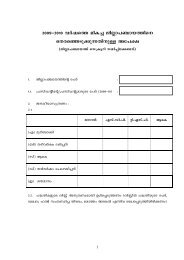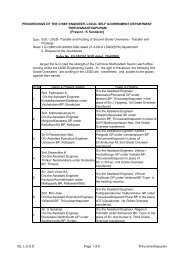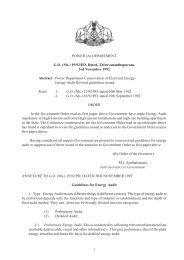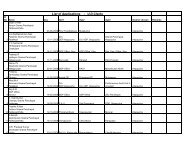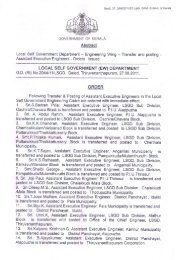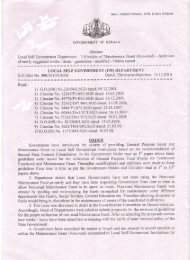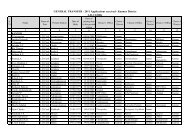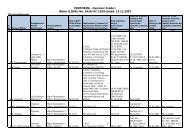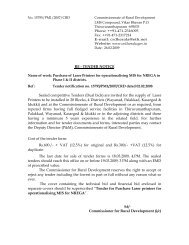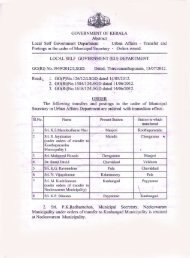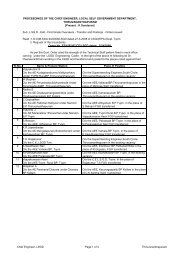Chapter 2 - Kerala Govt Logo
Chapter 2 - Kerala Govt Logo
Chapter 2 - Kerala Govt Logo
- No tags were found...
Create successful ePaper yourself
Turn your PDF publications into a flip-book with our unique Google optimized e-Paper software.
<strong>Chapter</strong> 2Policy, Legislation and Regulationand regulations have been known to fail because of the lack of implementation mechanisms.LSGs have a specific role on decision making and organizing implementation mechanisms withmutual linkage between government and civil society.Specific subjects/tasks that can be taken up by LSGsRecognize “wetland” as one of the non-negotiable land uses and “Common propertyresource” and resolve not to put these into any non wetland use by reclamation ordiversion. It is constitutionally possible by listing it under the item “common assets”.Among the standing Committees of LSGs, allocate the subject of wetland conservationspecifically to a relevant committee as part of the community assets of environmental,sanitation, or water resources significance. The objective should be to ensure sustainedstatus of the wetlands on the parameters of water spread area, pollution critieria, growthof aquatic weeds, regulation of fishing, use of commercial activities and most importantly,regulating use as well as participation of the polluter agencies in mitigating pollution.Evaluation of wetlands for their potential of contributing to the economic well being of thepeople in the vicinity. Non invasive economic activities can be tourism within the carryingcapacity, fishing and aquaculture, use of weeds for fiber based cottage industries, coirretting after assigning areas with suitable measures to mitigate the bad impact etc. Thishowever, would require scientific back up for which competent agencies are available in<strong>Kerala</strong>.Among the sectors devolved to LSGs, allocate specifically the management of wetlands to afunctionally competent line department. Among the existing ones include social forestry,minor irrigation (with qualification to the civil engineering), sanitation (environmental wingmay be created) or welfare.Demarcation of wetland boundaries on scientific basis to work on the areas which must bepreserved apart for ensuring the wetland environment intact. Any reclamation or diversionof such areas for any permanent development should not be planned.Provide for plan outlays for wetland eco-restoration. For this purpose, the managementaction plans can be coordinated by Department of Environment in consultation with theKSCSTE/civil society. Feasibility of a state plan sponsored LSG level scheme may also beconsidered to ensure fruitful partnership between the state government and LSGs forecorestoration of wetlands.Wetlands have been considered equally important for biodiversity and conservation valuesas unique habitats for birds especially migratory species. Much of the scientific work onthis aspect has actually been responsible for the famous Ramsar Convention and centrallysponsored scheme on wetlands conservation initially. Considering these facts, it is veryessential that any management planning takes into account the conservation value of theseecosystems while providing for their sustainable use. To ensure this, a strong interface ofempowered institutions (LSGs) will be required with the scientific institutions and civilsociety organizations. <strong>Kerala</strong> specially has rich repositories of information and knowledgeon wetland resource conservation and economic valuations. This can be organised throughthe department of environment.Conservation/management action plans by individual LSGIs are usually not feasible becausewetlands are often spread within the political area of several LSGIs and may have thewatershed extended over others. Therefore, a comprehensive plan with basin approach is




